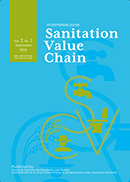Globally, access to improved water, sanitation and hygiene could prevent 58% of diarrheal deaths among under 5 children per year. In the urban slums of developing countries, overpopulation remains a contributing factor of limited access to clean drinking water and sanitary living conditions. This study examined the current situation of water use, sanitation, child health, nutritional status, and women’s hygiene awareness in an urban slum of Indonesia. The study was conducted in the densely populated area of Bandung, West Java Province, Indonesia. Questionnaires which probed for information regarding household socioeconomic status, condition of drinking water, toilet facilities, and understanding of child health were administered to 30 women. A group of 15 caretakers living with children aged below five years were interviewed regarding their procurement and use of domestic water, sewer system, health status of their children and awareness of good hygiene practices. In addition, researchers observed and photographed the household situation regarding the family’s drinking water, toilet facilities, and sewer during home visits. The study found the majority of participants used water in a safe and appropriate manner with respect to its source and purpose. No participants were found to use groundwater as drinking water. In conclusion, women living in the study area paid careful attention to the safety of drinking water. Although each house had a toilet facility, untreated wastewater was found to flow into a nearby river, which suggested that the people of the community had a low level of concern for appropriate wastewater treatment. Caretakers demonstrated excellent recognition of the importance of handwashing and the majority of participants displayed a high level of interest in maintaining good child health and nutritional status. Lastly, results from the sample of caretakers who were interviewed indicated that the health and nutritional status of the children studied were generally good.
View full abstract
